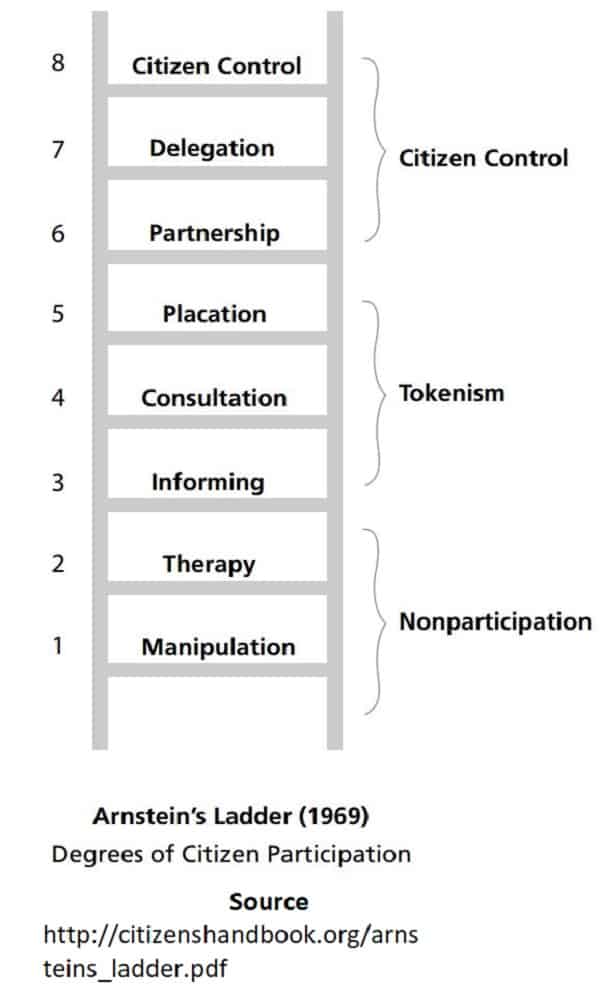Participatory planning or citizen participation aims to harmonise the views between different parties and different views to form a conclusion that is favourable to most of the population in the city or the country that the participatory planning is being conducted in. For instance, in most developed countries where there is an established council bodies for each city or district, participatory planning is adopted when there are major infrastructure projects being carried out in the city such as pedestrian bridges or a new building that is being erected. People usually gather in council chambers to voice their different opinions that the various civic bodies take into consideration when making major decisions for the cities. However, this is usually not a simple process and sometimes involves conflict between people of different perspectives. It is usually a long process that the citizen advisory board takes into consideration and prepares the reports or actions in such a way that there is no conflict. This said, many times there is conflict between the views of the public and the views of the government bodies and it usually cannot and does not try to please everyone.

Related: Community Participation | Types, Process & Facilitation
Sherry R Arnstein’s Ladder of Citizen Participation
Sherry Arnstein back in 1969 theorised the ladder of citizen participation, where she suggested the different aspects to citizen participation. She suggested that the process for citizen participation takes a long time and is based on a number of factors including whether the government is willing to hear what the people of the nation has to say and the ways in which it is considered important to the city. She starts from ‘non-participation’ which is manipulation and theory suggesting that the citizens don’t have any power over the decisions that are being made by governing bodies and only when partnership, delegation and citizen control comes into the picture, there is ‘citizen control’ which leads to citizen participation. Citizen participation is the most important factor in determining participatory planning.
In more recent years, this model has been carried out in more succinct cases through direct citizenship, riots and strikes where people’s voices are heard and taken into consideration by the government. Placemaking opportunities are also a big factor which has led to citizen partnership. Some government bodies are employing placemaking managers to create a more participatory society in their cities. Placemaking provides people the opportunity to be directly involved in various projects that are taking place in the city by contributing their own resources and being part of the bigger change that is taking place in cities. This is a subset of Arnstein’s ladder of citizen participation.
According to an article, the different aspects of Arnstein’s ladder is explained in more detail, which is as follows:
1. Manipulation and 2 Therapy – Both are non participative. The aim is to cure or educate the participants. The proposed plan is best and the job of participation is to achieve public support through public relations.
3. Informing – A most important first step to legitimate participation. But too frequently the emphasis is on a one way flow of information. No channel for feedback.
4. Consultation – Again a legitimate step attitude surveys, neighbourhood meetings and public enquiries. But Arnstein still feels this is just a window dressing ritual.
5. Placation – For example, co-option of hand-picked ‘worthies’ onto committees. It allows citizens to advise or plan ad infinitum but retains for power holders the right to judge the legitimacy or feasibility of the advice.
6. Partnership – Power is in fact redistributed through negotiation between citizens and power holders. Planning and decision-making responsibilities are shared e.g. through joint committees.
7. Delegation –Citizens holding a clear majority of seats on committees with delegated powers to make decisions. Public now has the power to assure accountability of the programme to them.
8. Citizen Control – Have-nots handle the entire job of planning, policy making and managing a programme e.g. neighbourhood corporation with no intermediaries between it and the source of funds.”

Related: Rational Planning Model, Healthy City Project, Advocacy Planning Concept
From the above description, it can be understood that there are various ways in which citizen participation can be adopted by the society. Either of the extremes – citizen control where only the general population have the full rights to power over major decisions and manipulation/therapy, where only the governing bodies have full control is not usually desirable. It needs to be a mix of both citizen power and government working together to achieve the major outcomes. The main aim of this ladder is to promote the voice of citizens in such a way that it does not cause major harm to the entire population. Extremist views on both sides are usually not approved by the governing bodies and the final decision is based on how the government views the participatory nature of the citizens. This is important in some societies where the views of the population is not heard and the general public doesn’t feel that their city is being represented accordingly.
Conclusion
In conclusion, participatory planning is an important method that needs to be advocated more strongly in the 21st century. Many different forms of citizenship and participatory models are being taken into consideration and this is derived from the Ladder of Citizen Participation. Arnstein’s model is quite dated but it is still relevant in today’s society. For this reason many other citizen participatory models have been taking into consideration especially in important planning issues such as climate change, housing and transport decision making. It is said that communities that work together and governments who take the views of their people are the most collaborative and functional.
Also Read: What is New Urbanism? | Definition, Concept & Benefits